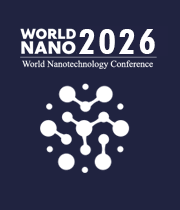Title : Electrical and infrared spectroscopy analysis of BiBaFeO3 doped nanocomposite gel polymer electrolytes [PVA:NH4CH3COO] system
Abstract:
Nanocomposite Gel polymer Electrolytes (NCGPEs) have superior ionic conductivity than solid polymer electrolytes, making them essential to batteries, super capacitors, fuel cells and sensors. Many gel polymer electrolytes (GPEs) have been created to improve mechanical integrity, ionic conductivity and electrochemical stability. Nano fillers can create nanocomposite gel polymer electrolytes with specified electrochemical characteristics. Proton conducting nanocomposite gel polymer electrolytes were made using polyvinyl alcohol (PVA) as the host polymer, ammonium acetate (NH4CH3COO) as the proton (H+) source, and BiBaFeO3 (BFO) as the nano filler via solution casting technique. The optimal room temperature conductivity of [PVA:NH4CH3COO:BiBaFeO3] NCGPE at 0.5 wt.% BiBaFeO3 is 1.05×10-3 Scm-1. FTIR shows ammonium salt complexing with the polymer host. To calculate the fraction of free NH4+ ions and ion aggregates, the FTIR spectra were examined and the peaks between 1380cm-1 and 1450 cm-1 were deconvoluted. The FTIR spectra were recorded on Bruker Alpha (Germany) with a resolution of 1cm-1 in transmission mode over the wave number runs from 400cm-1to 4000cm-1 at room temperature gather structural information in the composite system. The complex impedance measurement was carried out with help of a computer controlled electrochemical analyzer instrument USA (Model CHI608D,CH) upon application of small a.c. signal (20mV) across the sample; sandwiched between two platinum electrode to measure electrical conductivity in the frequency range (1Hz-100kHz). The relaxation time of ion jump and dc conduction with polarisation losses decreases with BFO added to the pristine gel due to NCGPEs' increased ionic conductivity. Dielectric studies indicate that all nanocomposites gel polymer electrolytes have a wide relaxation time distribution and ion cooperation.
Keywords: Gel polymer electrolyte, PVA:NH4CH3COO electrolyte, ionic conductivity, dielectric response.

![Electrical and infrared spectroscopy analysis of BiBaFeO3 doped nanocomposite gel polymer electrolytes [PVA:NH4CH3COO] system Lovely Ranjta, Speaker at Nanoscience Conferences](https://worldnanotechnologyconference.com/uploads/speakers/lovely-ranjta-9707.jpg)

